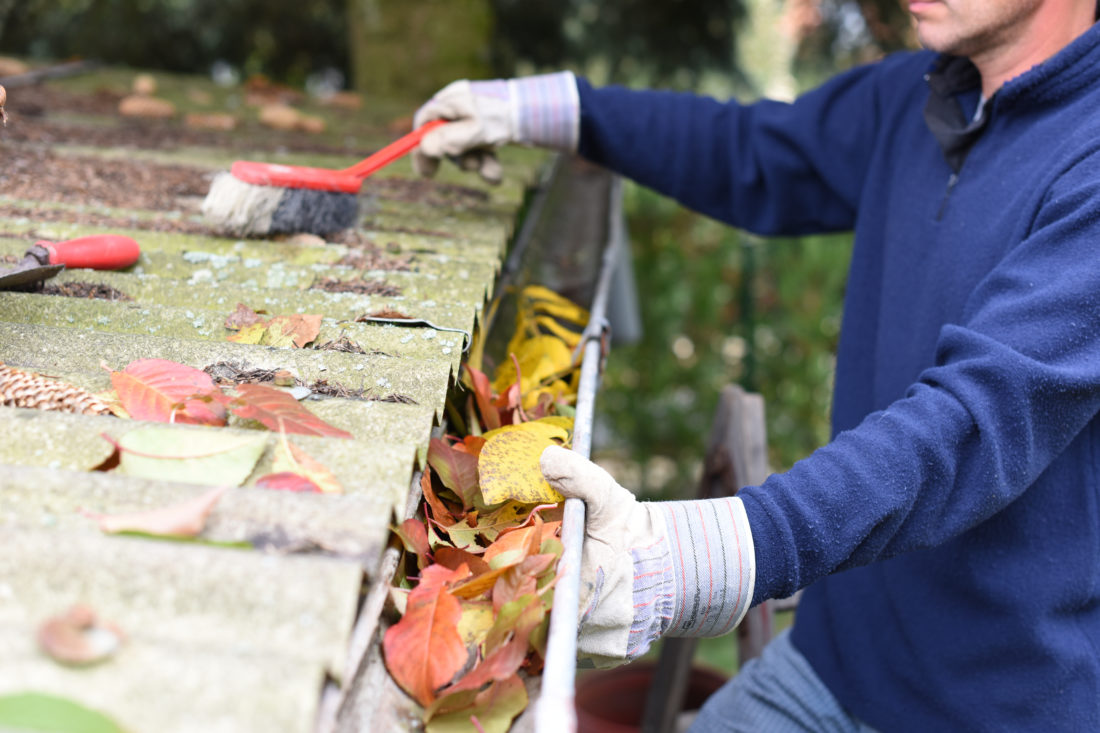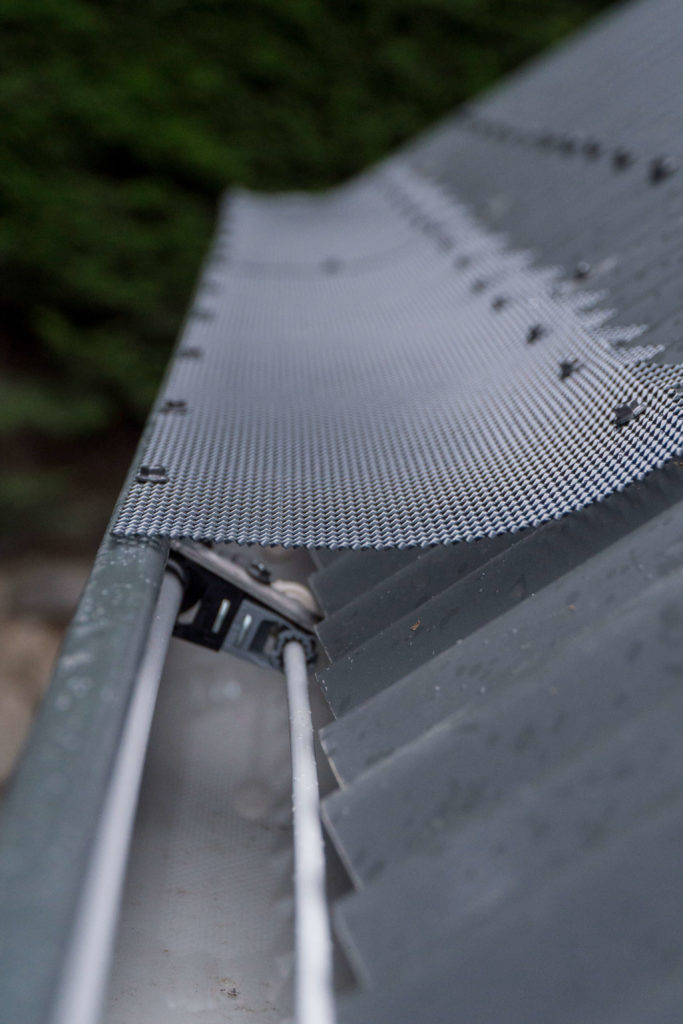
How to clean and repair your roof and gutters
Roof cleaning
How do I clean a roof
While you may think that cleaning your roof is a simple task, there are do’s and don’ts that you need to follow if you want to do it right.
Do these things:
- Use a sprayer attached to a garden hose that is filled with equal parts chlorine bleach and water or laundry-strength liquid chlorine bleach and water. Once you’ve finished spraying your roof, allow it to sit on the surface for 15 – 20 minutes before you rinse it with water
- Wet the surrounding plants with water and cover them with plastic. Once you’re done, rinse them again to ensure there is no chemical residue on the plants
- If it is algae on your roof, be patient. Algae will wash away during the next rainstorm and moss will eventually loosen
- Clean your roof on a cloudy day when there is little to no wind
- Determine that you can walk on the roof safely without anything collapsing or you slipping off. If you are up on the roof, wear shoes with good grip, rubber soles will help with slip resistance
Don’t do these things:
- Use a water blaster. This can loosen tiles and seriously damage your roof
- Ignore your surrounding plants as they can be damaged by chemical solutions used to clean the roof
- Reapply your chemical solution. Some take time to work
- Clean your roof on a sunny day, as this will cause the chemical solution to evaporate too quickly
- Clean your roof without checking all hazards to keep you safe
- Wait until your roof is completely covered in algae or moss
When do I need a professional
Believe it or not, there are professional roof cleaners and sometimes you need one. There aren’t many reasons to use a professional, but below are the few reasons why:
- When you don’t have time to do it yourself
- If you are worried about hurting yourself while on the roof
- If you have tried to remove the algae and moss yourself but it won’t budge
Health and Safety
Worksafe suggests that when planning to work on a roof, it is important to first try to eliminate the hazard by working from the ground, then isolate it by using scaffolding or edge protection. The third option is to minimise by using a total restraint system, however, the first two are recommended as priority controls.
Roof repairs
How do I repair my roof?
There can be many problems with your roof and a lot of them will require a professional to do the work. However, there are some jobs you can give a go yourself. If your roof is missing nails or nails are loose, replace them or tighten them. Sometimes a little silicone can go a long way too. If the problem is more than just a missing or loose nail, we suggest speaking to a professional.
How do I find a leak in my roof?
A leaking roof is not uncommon and there are ways to try to identify where the roof is leaking. First, we suggest that you look at the section of the roof which is ‘uphill’ from the stain on your ceiling or wall. When you’re inspecting this section of the roof, you will need to see whether there are any holes or penetrations in the material. Penetrations in your roof are the most common reason for a leak. In fact, it is not common at all for a leak to appear on its own.
Penetrations can include:
- Plumbing
- Roof vents
- Chimneys
- Dormers
- Anything else that cuts through the roof
If you have a manhole and can get in to view the roof from below, use a torch and look for signs of leaking, such as water stains, rust, black marks, or mould. If you cannot find the leak and have looked both top and bottom, get a friend to help. If you use a hose and wet the area where you think it is leaking, have one person inside to view where it is coming from.
Issues with leaking roofs
Many people won’t know they have a leak until it’s too late. Moisture leaking into your home through the roof will often lead to mould, and mould won’t stop growing until you eliminate the moisture. If you’d like to learn more about mould, click here.
When do I need a professional
As stated earlier, if a new nail or a bit of silicone isn’t going to fix the problem, it’s probably time to call in the experts. If a leak is left untreated for too long, it can cause serious structural damage to your home. Long-term exposure to certain types of mould can be very harmful to your health too.
Health and Safety
The health and safety controls for repairing your roof set by Worksafe are the same as cleaning your roof. To read more about assessing the hazards and safety of your roof click here.
Gutter cleaning
Gutter and spouting cleaning
While cleaning your gutters probably isn’t the job you’ve been chomping at the bit to get done, it is a job that needs to get done to ensure your property is maintained. A blocked gutter can lead to blocked pipes, and if your pipes are blocked this can cause leaks into the ceiling. This would make a wet winter even more miserable. Cleaning your gutters often will also help prevent rusting and extend the lifetime of the product.
How do I clean gutters
You may not believe it, but cleaning your gutter isn’t just simple, but it is also easy. Schedule time to clean your gutters twice a year. All you will need to do the job is:
- A ladder
- Heavy duty gloves
- Bucket
When you’re up the ladder, be sure to follow simple health and safety rules. To clean your gutters, put on your gloves and pull out all the leaves and debris stuck in there. If you’ve left it a little too long, or have quite a few trees close by, you may find that you need a scoop or brush to shift the stubborn muck in the gutter. Once you’ve done this, it’s simple – hose it away.
Gutter leaf blockers
Have you heard of gutter guards? No? Well, neither had some of us until recently. Gutter guards do just that, guard the gutters. They come either as a metal mesh that covers the guard and prevents leaves from falling in, or a foam insert.

Gutter repairs
Gutter and spouting repairs
Much like roofs, it is always best to have a professional do the work, but we have identified a list of jobs you can do yourself.
Loose gutters
The most common way to make sure your gutter doesn’t fall off the house is to install fascia hanger brackets. The installation of these is very easy. Simply hook the bracket under the front lip of the gutter then screw the other side of the bracket to the fascia of the house.
Annoying drips
Do you have a dripping sound that drives you insane? To eliminate this, simply tie a rope to one of the gutter hangers and run it down into the downpipe. The drops of water will cling to the rope instead of dropping the whole length of the downpipe. It’s important to note that this method can restrict water flow, so if your gutter is prone to overflowing, it may not be a good idea to implement.
Issues with broken gutters
While it is the New Zealand mentality to do it yourself, we always recommend leaving the big jobs to the pros. If you’re having major issues with broken gutters, it is probably time to speak to the professionals and get the job done right before more damage is caused.
The moral of the story here is always to look after your roof and gutters, but some jobs are just too big to do yourself. Our building inspection or condition assessment will help you identify whether there is a problem. Talk to one of our friendly team members today to book yours in.
